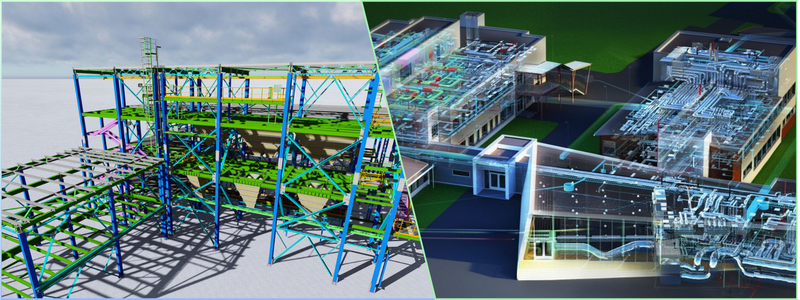With the ever-increasing demand for construction services, it’s become more critical for construction companies to maintain the highest productivity and operational efficiency possible. Business leaders realize that to achieve efficiencies, they must first overcome several challenges. The workforce is getting stretched out by the day, and with inconsistent access to building materials throughout the COVID-19 pandemic, business leaders must implement alternative strategies for their operations to stay profitable and efficient.
Despite the challenging business conditions, many construction leaders are implementing higher prices to offset the issues brought about by shortages in labor. Fortunately, modern technology can assuage some of the pressure and tension involved. In particular, architectural BIM services, or Building Information Modeling, has proven to be an effective tool for construction businesses to lower costs and improve overall productivity.
 Table of contents
Table of contents
- What is BIM?
- The critical role of BIM in the construction workload
- How BIM will define the future of construction companies
- How Cad Crowd can help
RELATED: Features and benefits of BIM services for architectural design companies
What is BIM?
Building Information Modeling (BIM) is a 3D model process that offers construction industry professionals the tools, insights, and data to plan, design, construct, and carry out their projects. With the help of BIM, all stakeholders involved in the project can have more seamless collaboration at every step of the building lifecycle. BIM allows construction professionals instant access to highly detailed and intricate digital representations of their projects. But more than being the mere 3D visual of the structure, Building Information Modeling includes several vital insights.
For example, experts can use BIM to check how every material will hold up over time. They can also predict future performances and estimate costs. The BIM design professional also ensures that every piece of information is updated and centralized in real-time to give everyone access to reliable and helpful data. Construction experts can also use BIM in line with other technologies to further improve its benefits and capabilities for the construction process. These include 3D printing, AI, IoT, augmented or virtual reality, robotics, and more.
RELATED: Do you know the BIM best practices for architectural design firms?
The critical role of BIM in the construction workload
Before the COVID-19 pandemic, almost half of businesses claimed to use BIM in one way or another. Since then, the technology has continued to see significant growth. As skilled labor becomes increasingly challenging to find, and with rework depleting the resources of most construction companies, BIM technology can help these companies enhance their planning process, test further construction configurations, and boost the efficiency of modular construction projects.
Thanks to these benefits, the construction industry can move beyond the obstacles and challenges plaguing it for years. Launching software that targets the construction industry can help engineers, architects, business leaders, and project managers to design and build more innovative buildings even with inconsistent and sometimes inadequate access to material and human resources.
How BIM will define the future of construction companies
Here’s how Building Information Modeling will define the future of construction companies:
Enhanced sustainability
One of the current enduring trends these days is green real estate. Residential and commercial buildings are the primary culprits as far as energy waste and depletion of resources are concerned. Studies revealed that they comprise an integral chunk of the Western world’s CO2 emissions, with 36% in the European Union and 40% in the United States. Construction experts can lower waste using BIM functionalities to evaluate the precise amounts of required materials.
RELATED: Building information modeling (BIM) freelance contractors on Cad Crowd
With BIM’s integrated evaluation and analysis tools, architectural 3D modeling designers can also compare the materials to identify more sustainable choices. These evaluation tools can also assist stakeholders in finding and gauging materials with lower carbon impact. Energy simulation modeling, shadow and daylighting analysis, and lifecycle assessment information can help design more energy-efficient buildings. These buildings offer many advantages, from improved air quality to lower energy consumption.

A clearer idea of project results
Most construction businesses regard rework as an unavoidable consequence of being part of the industry. Unfortunately, rework is getting increasingly expensive for construction companies, which is inevitable. Most of the rework results from misunderstandings when it comes to design, and business leaders should look for a means of sharing clearer design information earlier in the relationship.
Project managers in construction have a hard time visualizing the intended result of their construction projects. Construction companies bear these misunderstandings that ensue because of this inability in the form of rework. BIM technology reduces the gap by offering sandboxes where construction companies can design and share their vision with their clients. The sandboxes also offer stakeholders contextual data to guide their decisions throughout the project, including estimated timelines and costs.
RELATED: Why freelance engineers and architectural design firms need to use 3D building models
Better collaboration
Construction projects usually require substantial collaboration among everyone involved, from contractors to subcontractors, project managers, onsite workers, and architects. The extent to which the stakeholders can have effective communication dictates the level of efficiency of project completion. Even with modern collaboration tools and cloud-based data storage, construction company employees still use outdated methods of communication, including chat and email applications.
It can be challenging for stakeholders to get a more holistic view of plans and workflows relevant to the construction project, however with the help of BIM coordination professionals, the process can be streamlined. Because of BIM technology, every stakeholder can view the consolidated project model with real-time updates to reflect any modifications from managers or owners. It also means that each stakeholder can create better workflows and plans optimized to cater to the newest set of client requirements that reduce rework.
RELATED: Affordable building information modeling from CAD Crowd freelance contractors
Reliable cost estimates
The profitability and success of construction projects rely a lot on the ability of business leaders to perform and stick with effective plans for job costing. Many business leaders and project managers use cost estimates to identify the revenue and expense linked with every project. But despite the extensive use of this cost estimation, reports reveal that massive projects tend to go beyond the set budget. The ability to predict costs is made more difficult because of the pandemic’s trade impact, with construction’s base prices increasing even before the pandemic.
Materials sourced from overseas suppliers are getting more expensive, and it also became more challenging to coordinate with global partners. With the help of building information modeling designers business leaders use highly detailed modeling information and real-time cost data to perform job costing in such a way that will consider the requirements of the project and the latest prices of materials.
RELATED: Industry rates for BIM services & building information modeling costs
Shorter project lifecycles
The demand for construction services will continue to increase further in the next few years. During typical market conditions, construction companies hire extra labor to meet the increasing demand. However, reports revealed that many contractors are anxious about their workers lacking the skills necessary to do their jobs. This lack of skilled labor only indicates that construction companies will have a limited ability to complete and bid for projects.
For example, with BIM software, business leaders can determine the specific construction project areas that can utilize modular construction or offsite prefabrication. This interplay between state-of-the-art solutions helps construction companies reduce time spent on projects and boost automation. It also means that construction companies can cater to more clients during the same period required to finish a single project using traditional methods.
RELATED: CAD construction drawings: modernizing your company’s 2D & 3D drafting process

Smoother handover
BIM continues to offer ROI way after the completion of a construction project. Renovators and facility managers can access precise digital records throughout the structure’s lifecycle. With the help of 3D construction rendering services and BIM, it is easier for an owner to check the components of their building, from installation dates to warranty information and maintenance history. Convenient and easy access to these details helps guarantee efficient building management.
As for smart buildings with integrated sensors, the combination of BIM and AI can empower facility managers to analyze accumulated data and information for preventive maintenance. And inform architecture companies of their builds’ quality and deterioration over the years. Construction companies will learn from their mistakes for future builds. Some experts also suggest that design automation can become a reality soon because of the combination of machine learning and BIM.
RELATED: Hire a freelancer for BIM drafting & conversion services on Cad Crowd
How Cad Crowd can help
Despite the challenges spurred by the pandemic in the construction industry, the rise of new technology like BIM will hold the key to a brighter and better future for any construction company. Cad Crowd can connect you with BIM experts who can transform your architectural visions into a reality. Contact us for a free quote.
